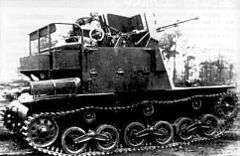Type 98 20 mm AAG Tank
| Type 98 anti-aircraft gun tank | |
|---|---|
 | |
| Place of origin | Empire of Japan |
| Specifications | |
| Weight | 22 tons |
| Length | 4.78 m (15 ft 8 in) |
| Width | 2.19 m (7 ft 2 in) |
| Height | 2.58 m (8 ft 6 in) |
| Crew | 5 |
|
| |
| Armor | 25 mm |
Main armament | 2x Type II 98 20 mm AA guns |
| Engine |
petrol 130hp |
| Suspension | Bell crank |
Operational range | ? |
| Speed | 42 km/h (26 mph) |
The Type 98 20 mm AAG (Anti-Air Gun) Tank was a Japanese self-propelled anti-aircraft gun using twin Soki Type II 20mm anti-air guns. They were combined with the chassis of the Type 98 Ke-Ni.[1] The gun crew worked from a raised platform with a modest amount of protection from the sides - the twin 20 mm guns fired through a large gun shield gave further protection for the crew from that direction.
In November 1941, development began on an anti-aircraft version of the Type 98 with a 20 mm AA gun.[1] During development of the AA gun tank, the Imperial Japanese Army experimented with various configurations.
Single gun variant
An earlier single gun prototype was designated the Type 98 Ta-Se anti-aircraft tank in November 1941.[1] The name taken from Taikū ("anti-air") sensha ("tank"). It was equipped with a single converted Type 98 20 mm AA machine cannon in a circumferential turret. During trials, it was determined that the chassis used for the Ta-Se was too small to be a stable "firing platform".[1][2] It did not enter production.[1]
Twin gun version

The prototype Type 98 20 mm AAG Tank was equipped with modified twin Type II 20 mm AA guns.[1][3] The guns are approximately the same as the Type 98 anti-aircraft cannon. The rate of fire was 300 rpm, and effective range was about 2,000m. The gunner sat in the gunner's seat right behind the gun. The platform allowed 360 degrees of rotation for both the gunner and the gun. A Type 100 air-cooled inline six-cylinder diesel engine was used to output 130 horsepower. Forward transmission included four stages, with one reverse speed. Type 98 Ke-Ni chassis and engine, on which the prototype was based managed a speed 42 km/h. It also did not enter production.[1]
See also
Notes
References
- Taki's Imperial Japanese Army Page
- Tomczyk, Andrzej (2007). Japanese Armor Vol. 5. AJ Press. ISBN 978-8372371799.